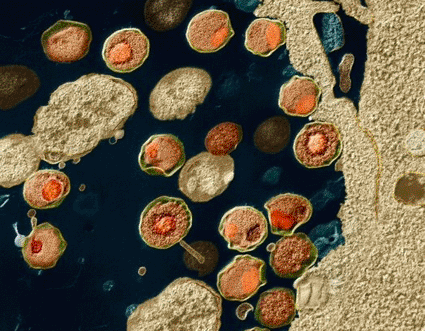Urine Samples Screened for Chlamydial Urogenital Disease
By LabMedica International staff writers
Posted on 12 Jul 2010
Cervical swabs and urine samples are used to screen women for bacterial diseases that are sexually transmitted. Posted on 12 Jul 2010
The Chlamydiaceae are gram-negative, obligate intracellular bacteria that form characteristic intracellular inclusions that are observable in cell culture by fluorescence microscopy after the application antigen-specific staining.

Image: Colored transmission electron micrograph (TEM) of Chlamydia trachomatis bacteria (Photo courtesy of the Eye of Science).
Although historically culture has been the "gold standard” for detection of Chlamydia trachomatis the enhanced sensitivity of amplified methods has led to their increasing adoption and in turn contributed to the rise in the number of reported cases of infection.
In a study carried out at the Haukeland University Hospital (Bergen, Norway), both cervical swabs and urine samples from women enrolled in a sexually transmitted infection clinic were screened for C. trachomatis. The molecular diagnostic test used was the Becton Dickinson ProbeTec (BDPT) Strand Displacement Assay (SDA) (Becton Dickinson, Franklin Lakes, NJ, USA). A total of 1,809 specimens were collected from 603 patients. Eighty women (13.4%) were positive for C. trachomatis. Among these, BDPT identified 72 and 73 as positive in cervix and urine samples, respectively. In cases of discrepant test results from a given patient, both samples were retested by another commercial kit, Cobas TaqManCT, (Roche Diagnostics, Basel, Switzerland) and an in-house polymerase chain reaction (PCR)-method. The sensitivity and specificity of BDPT was excellent regardless of sample category.
This study indicates that urine specimens are adequate for screening high-risk groups for C. trachomatis by the SDA method (BDPT). Urine samples may be particularly important in screening young people who are asymptomatic. Such an approach may facilitate early detection and treatment of the target groups for screening, and be cost-effective for patients and the health services.
It is estimated that 89 million new cases of genital Chlamydia infection occur worldwide in the age group 15 to 49 years and in the US it is estimated that four million cases transpire annually. In women, cervicitis, pelvic inflammatory disease (PID), ectopic pregnancy, and acute or chronic pelvic pain are frequent complications. C. trachomatis is also an important neonatal pathogen, where it can lead to infections of the eye (trachoma) and pulmonary complications. The bacterium can cause prostatitis and epididymitis in men.
Related Links:
Haukeland University Hospital
Becton Dickinson
Roche Diagnostics













